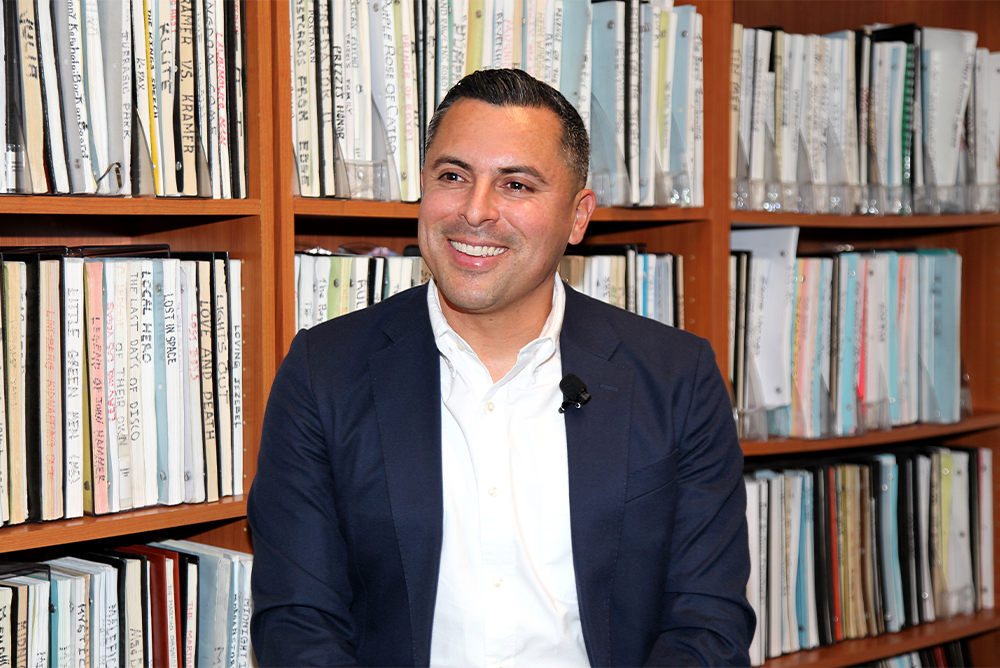
Photo by Aaron Salcido.
Rudy Mondragón is a UC Chancellor’s Postdoctoral Fellow in the Institute for Research on Labor and Employment at the University of California, Los Angeles. Before moderating the Zócalo program “What Does Boxing Owe Its Champions?”—presented in partnership with UCLA College, Division of Social Sciences and ASU Global Sport Institute—he chatted with us in the green room about photography, his research, and what connects him to boxing.
What is your favorite ring entrance song?
My favorite ring entrance song was Floyd Mayweather when he fought against Oscar De La Hoya and he used 50 Cent’s live performance of “Straight to The Bank.” It’s a trash-talking song. It’s basically telling his opponent, I’m going to beat you, and this is going to be easy money, and I’m going to laugh on my way to the bank.
Did you play any sports growing up?
I played soccer. And I ended up getting a Division I scholarship to play at UC Irvine. So that’s how I got to college.
Have you ever boxed?
I didn’t pick up boxing until I started studying boxing as a doctoral student. And so, I picked it up in my later years. I sparred one time, and that’s all it took for me to realize that I didn’t want to spar, because I might have been concussed, and at the very least had a very, very bad migraine.
You acquired Carlos Hernández’s boxing shorts for the Smithsonian. How did that come to be?
I went to a boxing weigh-in, and I was photographing one of the fighters. And a gentleman sits next to me and he says, Hey, can I sit next to you? I want to take photos. I said, Of course. And then the emcee of the event gets on the microphone, and says, ladies and gentlemen, let’s give a round of applause to the first world champion of El Salvador! I was looking around to see where this champion was because I didn’t know about him. And everybody was looking in my direction. Turns out he was the gentleman that asked me if he could sit next to me. I said, Hey, can I talk to you after this event, because I have an opportunity to share with you? He ended up donating a pair of boxing trunks, the ones that he wore to the championship match. Funny enough, he just tagged me on a post this morning. He’s in D.C. right now with his daughter [and they went to the Smithsonian to see his donation on view for the first time]. That’s for me one of the special moments of being able to use my platform as an academic and a person who’s connected to the museum world—to be able to do my part to create opportunities for boxers so that their stories live on.
You’re an avid photographer. What do you seek out in your work?
I wanted to capture the perspective of a researcher, and so I started taking my camera to boxing gyms and just documenting photos of what I saw from the perspective of a researcher. I wanted to distinguish the photos from a sports media photographer. I like capturing tender moments, intimate moments, when fighters are working with their trainers or fighters are what their children or fighters are experiencing some kind of struggle or hardship. When fighters have tattoos, I photograph the messages that they have embedded on their bodies. For me, it’s a way of engaging in research, but also to remember what I’ve seen in the field. I have an archive of photos that I want to share eventually, to create some kind of exhibit that speaks to a researcher’s perspective, a lens that a researcher in the sports field captures with their camera, which is different than what we typically see in sports photography.
What’s something outside of boxing that you’ve learned from boxing?
The lessons that I’ve learned from doing this work is how fighters find dignity in this kind of harsh, high-risk sport that oftentimes doesn’t pay fighters well. Fighters make meaning in entering the ring and fighting for a crowd, whether it’s 50 people or thousands of people, they feel seen. And so there’s dignity in the work that they do. And they’re the hardest workers that I’ve seen. For fighters that aren’t eating and living off of boxing alone, they’re also working two other jobs outside of boxing to earn a living. I’ve seen how boxers are so diligent and hard-working. And also need each other. For women’s boxing, in particular. Kali [“KO” Mequinonoag Reis] is on the panel, and one thing I’ve learned from Kali is how women boxers, for the most part, tend to see themselves as needing each other. In the U.S., there’s about 3,300 men registered in boxing professionally. And there’s about 150 women. So that’s a huge gap in terms of representation. And so women boxers will rip each other’s heads off in the ring with the spirit of “I need you just as much as you need me so that we can put women’s boxing on the map.” And it’s a very collective way of thinking of violence in the ring.



